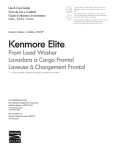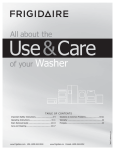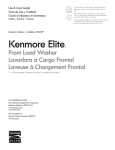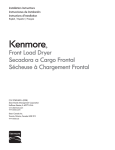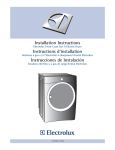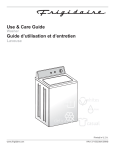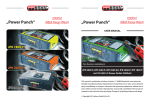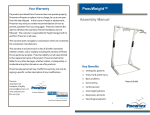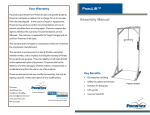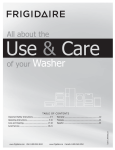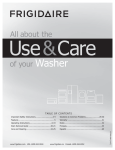Download Kenmore 3.9 cu. ft. Front-Load Washer - White ENERGY STAR Owner's Manual
Transcript
Use & Care Guide Guía de Uso y Cuidado Guide d’utilisation et d’entretien English / Español / Français For best results, a lower-sudsing, HE High Efficiency Detergent made for front loading washers must be used. Para obtener mejores resultados, una baja espuma, H.E. Alta eficiencia de detergentes para lavadoras de carga hizo frente debe ser utilizado. Pour de meilleurs résultats, et un bas niveau de mousse, un détergent haute-efficacité HE conçu pour les laveuses à chargement frontal doit être utilisé. Models/ Modelos / Modèles: 417.4112* Kenmore ® Front Load Washer Lavadora a Cargo Frontal Laveuse à Chargement Frontal * = Color number, número de color, le numéro de couleur P/N 137631200 A (1308) Sears Brands Management Corporation Hoffman Estates, IL 60179 U.S.A. www.kenmore.com www.sears.com Sears Canada Inc. Toronto, Ontario, Canada M5B 2C3 www.sears.ca ® Record Model/Serial Numbers Important Safety Instructions The model and serial numbers of your washer are found on the washer serial plate located on the inside of the door. Record and retain these numbers. Recognize safety symbols, words and labels Model Number ____________________ Safety items throughout this manual are labeled with a WARNING or CAUTION based on the risk type as described below: Serial Number ____________________ Purchase Date ____________________ Definitions This is the safety alert symbol. It is used to alert you to potential personal injury hazards. Obey all safety messages that follow this symbol to avoid possible injury or death. This Use and Care Guide provides general operating instructions for your washer. It also contains information about features for several other models. Your washer may not have every feature included. The instructions in this manual and all other literature included with this washer are not meant to cover every possible condition and situation that may occur. Good safe practice and caution MUST be applied when installing, operating and maintaining any appliance. Use the washer only as instructed in this Use & Care Guide. DANGER DANGER indicates an imminently hazardous situation which, if not avoided, will result in death or serious injury. WARNING WARNING indicates a potentially hazardous situation which, if not avoided, could result in death or serious injury. Table of Contents Important Safety Instructions ............................................ 2-3 Warranty / Protection Agreement .......................................4 Features ....................................................................................5 Operating Instructions...................................................... 6-14 Stain Removal Guide ...................................................... 15-16 Care and Cleaning .........................................................17-20 Solutions to Common Problems .................................... 21-24 Español ...................................................................................25 Français ................................................................................. 48 CAUTION CAUTION indicates a potentially hazardous situation which, if not avoided, may result in minor or moderate injury. IMPORTANT IMPORTANT indicates installation, operation or maintenance information which is important but not hazard-related. Save these instructions for future reference. 2 Important Safety Instructions • To prevent personal injury or damage to the washer, the electrical power cord of the washer must be plugged into a properly grounded and polarized 3-prong outlet. The third grounding prong must never be removed. Never ground the washer to a gas Grounding type wallll receptacl wa receptacle pipe. Do not use an extension cord or Do not, under anyy circumstances, an circumstances, an adaptor plug. cut, remo remove ve, WARNING To reduce the risk of fire, electrical shock, or injury to persons when using this washer, comply with the basic warnings listed below. Failure to comply with these warnings could result in serious personal injuries. You can be killed or seriously injured if you don’t follow these Important Safety Instructions: or bypass bypass th the grounding gr ounding prong. prong. PREVENT FIRE • Do not wash items that have been previously cleaned in, soaked in, or spotted with gasoline, cleaning solvents, kerosene, cooking oils, waxes, etc. Do not store these items on or near the washer. These substances give off vapors or chemical reactions that could ignite or explode. • Do not put oily or greasy rags or clothing on top of the washer. These substances give off vapors that could ignite the materials. • Do not add gasoline, cleaning solvents, or other flammable or explosive substances to the wash water. These substances give off vapors that could ignite or explode. • Under certain conditions, hydrogen gas may be produced in a hot water system that has not been used for 2 weeks or more. HYDROGEN GAS IS EXPLOSIVE. If the hot water system has not been used for such a period, before using the washer, turn on all hot water faucets and let the water flow from each for several minutes. This will release any accumulated hydrogen gas. Hydrogen gas is flammable; do not smoke or use an open flame during this time. • Do not store or use gasoline or other flammable vapors or liquids in the vicinity of this or any other appliance. • Failure to comply with these warnings could result in fire, explosion, serious bodily injury and/or damage to the rubber or plastic parts of the washer. PROTECT CHILDREN • Do not allow children to play on or in the washer. Close supervision of children is necessary when the washer is used near children. As children grow, teach them the proper, safe use of all appliances. • Destroy the carton, plastic bag and other packing materials after the washer is unpacked. Children might use them for play. Cartons covered with rugs, bedspreads or plastic sheets can become airtight chambers. • Keep laundry products out of children’s reach. To prevent personal injury, observe all warnings on product labels. • Before the washer is removed from service or discarded, remove the washer door to prevent accidental entrapment. • Failure to comply with these warnings could result in serious personal injuries. PREVENT INJURY • To prevent shock hazard and assure stability during operation, the washer must be installed and electrically grounded by a qualified service person in accordance with local codes. Installation instructions are packed in the washer for installer’s reference. Refer to INSTALLATION INSTRUCTIONS for detailed grounding procedures. If the washer is moved to a new location, have it checked and reinstalled by a qualified service person. Power cord with Power 3-prong gr grounded ounded plug • Follow package directions when using laundry products. Incorrect usage can produce poisonous gas - resulting in serious injury or death. • Do not combine laundry products for use in 1 load unless specified on the label. • Do not mix chlorine bleach with ammonia or acids such as vinegar. PREVENT INJURY AND DAMAGE TO THE WASHER To prevent serious personal injury and damage to the washer: • All repairs and servicing must be performed by an authorized servicer unless specifically recommended in this Use & Care Guide. Use only authorized factory parts. • Do not tamper with controls. • Do not install or store the washer where it will be exposed to the weather. • Do not install on carpet. Install washer on a solid floor. It may be necessary to reinforce the floor to prevent vibration or movement. • To reduce the risk of electric shock, disconnect this appliance from the power supply before attempting any user maintenance. Turning the controls to the OFF position does not disconnect this appliance from the power supply. • To prevent injury, do not reach into the washer while parts are moving. Before loading, unloading or adding items, push in the cycle selector knob and allow the drum to coast to a complete stop before reaching inside. • This washer is equipped with an electrical overload protector. The motor will stop if it becomes overheated. • Failure to comply with these warnings could result in serious personal injuries. 3 Kenmore Appliance Warranty Master Protection Agreements One Year Limited Warranty When installed, operated and maintained according to all instructions supplied with the product, if this appliance fails due to a defect in material or workmanship within one year from the date of purchase, call 1-800-4-MY-HOME® to arrange for free repair. If this appliance is used for other than private family purposes, this warranty applies for only 90 days from the date of purchase. Congratulations on making a smart purchase. Your new Kenmore® product is designed and manufactured for years of dependable operation. But like all products, it may require preventive maintenance or repair from time to time. That’s when having a Master Protection Agreement can save you money and aggravation. The Master Protection Agreement also helps extend the life of your new product. Here’s what the Agreement* includes: • Parts and labor needed to help keep products operating properly under normal use, not just defects. Our coverage goes well beyond the product warranty. No deductibles, no functional failure excluded from coverage – real protection. • Expert service by a force of more than 10,000 authorized Sears service technicians, which means someone you can trust will be working on your product. • Unlimited service calls and nationwide service, as often as you want us, whenever you want us. • “No-lemon” guarantee – replacement of your covered product if four or more product failures occur within twelve months. • Product replacement if your covered product can not be fixed. • Annual Preventive Maintenance Check at your request – no extra charge. • Fast help by phone – we call it Rapid Resolution – phone support from a Sears representative on all products. Think of us as a “talking owner’s manual”. • Power surge protection against electrical damage due to power fluctuations. • $250 Food Loss Protection annually for any food spoilage that is the result of mechanical failure of any covered refrigerator or freezer. • Rental reimbursement if repair of your covered product takes longer than promised. • 25% discount off the regular price of any non-covered repair service and related installed parts. Once you purchase the Agreement, a simple phone call is all that it takes for you to schedule service. You can call anytime day or night, or schedule a service appointment online. The Master Protection Agreement is a risk free purchase. If you cancel for any reason during the product warranty period, we will provide a full refund. Or, a prorated refund anytime after the product warranty period expires. Purchase your Master Protection Agreement today! Some limitations and exclusions apply. For prices and additional information in the U.S.A. call 1-800-827-6655. * Coverage in Canada varies on some items. For full details call Sears Canada at 1-800-361-6665. Sears Installation Service For Sears professional installation of home appliances, garage door openers, water heaters, and other major home items, in the U.S.A. or Canada call 1-800-4-MY-HOME®. This warranty covers only defects in material and workmanship. Sears will NOT pay for: 1. Expendable items that can wear out from normal use, including but not limited to filters, belts, light bulbs and bags. 2. A service technician to instruct the user in correct product installation, operation or maintenance. 3. A service technician to clean or maintain this product. 4. Damage to or failure of this product if it is not installed, operated or maintained according to all instructions supplied with the product. 5. Damage to or failure of this product resulting from accident, abuse, misuse or use for other than its intended purpose. 6. Damage to or failure of this product caused by the use of detergents, cleaners, chemicals or utensils other than those recommended in all instructions supplied with the product. 7. Damage to or failure of parts or systems resulting from unauthorized modifications made to this product. Disclaimer of implied warranties; limitation of remedies Customer’s sole and exclusive remedy under this limited warranty shall be product repair as provided herein. Implied warranties, including warranties of merchantability or fitness for a particular purpose, are limited to one year or the shortest period allowed by law. Sears shall not be liable for incidental or consequential damages. Some states and provinces do not allow the exclusion or limitation of incidental or consequential damages, or limitations on the duration of implied warranties of merchantability or fitness, so these exclusions or limitations may not apply to you. This warranty applies only while this appliance is used in the United States and Canada.* This warranty gives you specific legal rights, and you may also have other rights which vary from state to state. * In-home repair service is not available in all Canadian geographical areas, nor will this warranty cover user or servicer travel and transportation expenses if this product is located in a remote area (as defined by Sears Canada Inc.) where an authorized servicer is not available. Sears Brands Management Corporation, Hoffman Estates, IL 60179 Sears Canada Inc., Toronto, Ontario, Canada M5B 2C3 4 Features Cycle Selector Control Lock LED Display Laundry Product Dispenser Drawer Door Latch with Safety Lock Door Striker Inner glass with small article redistribution ramp Vent Latch Stainless Steel Wash Drum Adjustable Leveling Legs As an ENERGY STAR® Partner, Sears Brands Management Corporation has determined that this product meets the ENERGY STAR® guidelines for energy efficiency. 5 Cascading Wash Vanes Operating Instructions 5 This manual covers many models and not all cycles, options, or features listed are available on every model. Consoles shown above for reference only. Your model may differ. Cycle Selection Turn the cycle selector in either direction to the cycle desired. Bulky|Bedding This cycle is designed for large items such as blankets, sheets, mattress pads, duvet covers and similar items. Normal Use this load for cotton, linen, towels, shirts, sheets, denims and mixed loads. Casual Use this cycle for cottons and blends with a permanent press or no-iron finish. Delicates Use this cycle for lightly soiled knits and delicates which require gentle washing. Rinse & Spin Select Rinse & Spin for loads that need a cold water rinse or to add fabric softener that may have been omitted in a regular cycle. Add the fabric softener to the dispenser chamber. Select the spin speed appropriate for the load. For best results Follow the fabric care label instructions on items to be washed. To change the cycle once it has begun, press the CANCEL button before selecting a new cycle. Just turning the cycle selector knob to another selection will not change the cycle. 6 Operating Instructions Cycle Settings Hot Use this setting for heavily soiled colorfast fabrics such as towels, bedding, and children’s clothing. For best results Follow the fabric care label instructions on items to be washed. Warm Use this setting for normally soiled white or colorfast cottons and blends. Appropriate wash temperature, spin speeds, soil level and options will automatically be displayed for each cycle. The settings can be changed before the cycle is started. To protect your fabrics, not all settings and options are available with every cycle. The indicator will not light if the setting is not available with that cycle. Modifications for each cycle will be remembered and recalled each time that cycle is selected in the future. If changes are attempted after the cycle starts, the lights will blink, the signal will beep and “Err” will be displayed. 5 Cool Use this setting for normally soiled sheets, casual items and washable woolens. Cold Some warm water will automatically blend with cold tap supply to achieve a precise Wash Temp Cold. Use this setting for lightly soiled non-colorfast items, knits, delicates, and hand washables. To return to factory settings, press these two buttons at the same time and hold until the signal sounds. Tap Cold Wash and rinse temperatures are equivalent to temperature of cold tap supply. Use this selection for lightly soiled non-colorfast items, knits, delicates, and hand washables and other fabrics and colors that are prone to dye transfer. For use with cold water detergents. NOTE To change settings once the cycle starts, press PAUSE, adjust the setting and press START to resume the cycle. SPIN SPEED To protect your fabrics, not all spin speeds are available with every cycle. The indicator will not light if the setting is not available with that cycle. Extra High, High, Medium and Low spin speeds are available for appropriate cycles. The spin speed and/or duration of final spin vary from model to model and cycle to cycle. Increasing the spin speed will extract more water, decrease drying time and conserve energy. Decreasing the spin speed will reduce wrinkling. Select Low spin speed to gently spin items that should be line dried. Use No Spin to omit the final spin at the end of the cycle. The load will be very wet. Remove items from the wash drum to drip dry or select a Rinse & Spin cycle to remove excess water at a more convenient time. WASH WATER TEMPERATURE To change the preset temperature, press the Wash Temp button to scroll to the desired setting. Select a wash water temperature according to fiber content, colorfastness and soil level. A cold water rinse saves energy and reduces wrinkling. To protect your fabrics, not all temperatures are available with every cycle. The indicator will not light if the setting is not available with that cycle. Wash Temp water temperatures are automatically regulated to maximize detergent effectiveness and improve washing performance. The water heater setting and its distance from the washer, water usage in other parts of the home, and seasonally low ground water temperature in some geographic areas can affect water temperature. SOIL LEVEL Adjust the wash time based on the soil level of each load. Heavy, Normal, and Light soil levels are available. 7 Operating Instructions Cycle Options To select an option, press Options until the indicator for the desired option flashes, then press Select. If an option is not available for a cycle, the indicator will not light. Follow the same steps to delete an option. Chime A signal will sound at the end of the cycle if this option is selected. The signal has an adjustable volume level or can be turned off. Stain Boost Use the Stain Boost option to add a 5-minute soak in the middle of the wash portion of select cycles. Save Energy The Save Energy option defaults to a cold temperature setting (in most cycles) and also extracts more water to reduce drying time. Extra Rinse Use this option when additional rinsing is desired to remove excess dirt and detergent. It is recommended for heavily soiled loads or if household members have sensitive skin. Occasionally, a setting and option in the same cycle will conflict with each other, like No Spin (or Low Spin) and Save Energy. When this happens, the energy saver option will override any incompatible selections. The options selected for the cycle will be remembered and recalled each time that cycle is selected in the future. To return to factory settings, press the START/PAUSE and Select buttons at the same time and hold until the signal sounds. NOTE To change the options after the cycle starts, press PAUSE, adjust the options and press START to resume the cycle. 8 Operating Instructions Washer Settings Chart 5 9 9 9 9 9 9 9 9 9 9 9 9 9 9 9 9 9 9 9 9 9 Rinse & Spin 9 9 9 9 9 Delicates Normal 9 9 9 9 9 Casual Bulky|Bedding These Temperature, Spin Speeds, Soil Levels and Options are available with the following cycles: 9 9 9 9 9 9 9 9 9 9 9 9 9 9 9 9 9 9 9 9 9 9 9 9 9 9 9 9 9 9 9 9 9 Wash Temp Hot Warm Cool Cold Tap Cold Spin Speed Extra High High Medium Low No Spin Soil Level Heavy Normal Light Options Chime Stain Boost Save Energy Extra Rinse Delay Start 9 = Available selections. 9 9 = Cycle defaults. = Non-modifiable presets. 9 9 9 Operating Instructions Other Features Delay Start Press Delay Start to select a wash time convenient to your schedule or during off peak energy hours. The delay time selected will be displayed and begin counting down when you select START. Control Lock To avoid having someone accidentally start the washer, press Options and Select at the same time and hold for 5 seconds until “LOC” is displayed alternately with the estimated cycle time. To unlock the controls, press Options and Select at the same time and hold 5 seconds until “LOC” is no longer displayed. 5 Status Display/Status Lights The estimated total cycle time will be displayed when the cycle is selected. The time may increase if water pressure is low, oversudsing occurs or the load becomes unbalanced. The estimated remaining cycle time is displayed during the cycle. The following indicators may be lighted during the cycle: • Door Lock • Sensing • Wash • Touch Pause to Add a Garment 5 Press and hold both for five seconds to lock or unlock the controls. Vent Latch Help prevent odor buildup and mildew between washes by utilizing your washer’s vent latch feature. To apply the vent latch, (1) open the door slightly, (2) lift the latch arm and then (3) press the arm down onto the plastic door strike, snapping it in place. The vent latch can be released either of two ways - by pulling door out and manually returning latch arm to lower position or by pushing door shut and allowing latch arm to continue its pivot upward. SNAP HINGE 3 IMPORTANT Do not attempt to close door if vent latch arm is disengaged and arm is in an outward position. Return latch arm to lower position before closing and latching the door. 2 NOTE 1 The vent latch may become dislodged from hinge point if door closure is attempted while latch arm is not in an acceptable closing position. The latch arm can be snapped back in at the hinge location. Washer will still operate without latch arm installed. 10 Operating Instructions Operating Your Washer • Place delicate and small items such as bras, hosiery and baby socks in a mesh bag. WARNING To reduce the risk of fire, electric shock or injury to persons, read these IMPORTANT SAFETY INSTRUCTIONS in this Use and Care Guide before operating your washer. 1 Sort laundry into loads that can be washed together. (Mesh bag not included.) 3 Pretreat stains and heavy soil. WHITES • See Stain Removal Guide in this guide for safe, successful stain removal instructions. CASUAL • Sort items by TO W E L S C O LO R S recommended cycle and water temperature. • Separate white, light and colorfast items from dark and non-colorfast items. • Separate items that shed lint from items that attract lint. Casual, synthetic, knit, and corduroy items will pick up lint from towels, rugs, and bedspreads. • Separate heavily soiled items from lightly soiled items. • Separate lacy, sheer, loosely knit, or delicate items from durable items. • Do not machine wash items containing fiberglass. Small particles of fiberglass left in the drum may transfer to fabrics in other loads and cause skin irritation and/or damage to fabrics. 4 Add laundry load to washer. 2 Prepare items for washing. • Empty pockets. • Combine large and small items in a load. • Load large items first. Large items should not be more than half the total wash load. • Washing single items such as a sweater, towel or jeans is inefficient and may cause an out-of-balance load. Add 1 or 2 similar items to help balance the load. • Wash a single heavy item such as a king-sized comforter, bedspread or sleeping bag separately. • The washer can be fully loaded, but the items should not be tightly packed. The door should close easily. • Brush off lint and dirt. Shake out rugs and beach towels. • Close zippers, fasten hooks, button buttons, tie strings and sashes, and remove non-washable trims and ornaments. • Mend rips and tears to prevent further damage during washing. • Turn knit items inside out to prevent pilling. 11 Operating Instructions Operating Your Washer, continued 5 Add laundry products to the dispenser. NOTE For best results From time to time you may see water in the “LIQUID BLEACH” and “FABRIC SOFTENER” chambers. This is part of the normal operation of the washer. Use a low-sudsing, high efficiency detergent to prevent oversudsing in front load washers. Look for this symbol on the detergent label: Liquid Chlorine Bleach • If desired, add liquid chlorine bleach to the chamber labeled “LIQUID BLEACH” and marked with this symbol . • Fill to the MIN line for small loads or the MAX line for large loads. • DO NOT fill above the maximum fill line. Detergent, liquid chlorine bleach and liquid fabric softener will be dispensed at the proper times in the cycle. IMPORTANT Open and close the dispenser drawer slowly. Closing the drawer too quickly could result in early dispensing of the bleach or fabric softener. IMPORTANT To prevent fabric damage, do not overfill the “LIQUID BLEACH” chamber or pour liquid chlorine bleach directly onto the load. • Add color-safe bleach with the detergent. Liquid Fabric Softener • If desired, pour the recommended amount of liquid fabric softener into the chamber labeled “FABRIC SOFTENER” and marked with this symbol . • Fill to the MIN line for small loads or the MAX line for large loads. • DO NOT fill above the maximum fill line. Liquid or Powder Detergent NOTE • Use the cap or scoop provided by the detergent manufacturer to measure the amount recommended. • Detergent dosage may need to be adjusted for water temperature, water hardness, load size and soil level. To prevent staining, do not overfill the “FABRIC SOFTENER” chamber or pour liquid fabric softener directly on the wash load. Other Wash Products • Use of a fabric softener-dispensing ball is not recommended in tumble action washers. Color-safe bleach, water conditioner, detergent booster and enzyme products may be added with the detergent. Put liquid products with liquid detergent in the “DETERGENT WASH” chamber or powder products with powder detergent in the “DETERGENT WASH” chamber. 6 Select the appropriate cycle and settings for the load. • Turn the cycle selector knob in either direction to select the cycle desired. • The estimated cycle time, suitable wash and rinse water temperatures, final spin speed, soil level, and options for each cycle will be indicated for the cycle selected. See the “Washer Settings Chart” for more details. • To change the settings, press the Wash Temp, Spin Speed and Soil Level buttons to scroll to the desired settings. IMPORTANT Do not mix liquids and powders. IMPORTANT Use of multi-product (detergent plus softener) sheets or color-absorbing sheets NOT recommended. They could disable your machine and result in unwarranted repair costs. 12 Operating Instructions Operating Your Washer, continued • To select or delete an option, press Options; then, while the indicator is blinking, press Select. The indicator will light when the option has been selected. It will no longer be lighted when the option has been deleted. • If changes to the settings or options are attempted after the cycle starts, you will hear several beeps when the buttons are pressed. To change the settings or options, press PAUSE, make the new selections and press START again. • To change the cycle once the cycle has begun, press Cancel, select a new cycle, and press START again. Just turning the cycle selector knob will not change the cycle. • To stop the cycle, press CANCEL. NOTE To provide the best care for your laundry, not every setting or option is available with every cycle. If a setting or option is not available for the cycle selected, the indicator will not light. NOTE • Adjustments to a cycle will be remembered and recalled each time that cycle is selected in the future. If the cycle is interrupted during spin, it will take approximately 2-3 minutes for the door lock to release. DO NOT force open the door. To return to factory settings, press these two buttons at the same time and hold until the signal sounds. • A signal will sound at the end of the cycle if the Chime option has been selected. • Remove items from the washer when the cycle ends and place in dryer, line dry or dry flat as directed on the fabric care label. 5 7 Start the washer. For best results • Close the door and press START. The washer will not operate with the door open. “PAU” will be displayed as a reminder to close the door. • Select Delay Start to delay the beginning of the cycle, if desired. • As a safety measure, the door will automatically lock during the entire wash cycle and the Door Lock indicator will be lighted. • “TOUCH PAUSE TO ADD A GARMENT” To add a forgotten item to the wash drum, press PAUSE and open the door. “PAU” will be displayed alternately with the estimated remaining cycle time. Add the item, close the door and press Start to resume the cycle. Follow the fabric care label instructions on items to be dried. • Excess wrinkling, color transfer or odors may develop in items left in the washer after the cycle has ended, if not removed promptly. CAUTION ENTRAPMENT and TIP-OVER HAZARD Do not leave the door open if there are small children or pets present. An open door could entice children to hang on the door or crawl inside the washer. If there are no small children present, you may leave the door ajar to prevent odor build up. 13 Operating Instructions Normal Operating Sounds A You may or may not hear the following sounds from your new washer: A. DRAIN HOSE The washer has a flexible drain hose to carry water from the washer to the stand pipe of your home. You will hear water flowing into your stand pipe. This is a normal part of the operation of the washer. B. WATER VALVES/DISPENSER As water enters the dispenser system, it is common to hear a water flowing sound. This normal sound will vary slightly based on the water pressure in your home. C. DRAIN PUMP Your washer is equipped with a high velocity drain pump. It is normal to hear humming and gurgling sounds as water is pumped from the washer. Both of these sounds are normal and indicate that your pump is functioning correctly. D. HIGH SPEED MOTOR A powerful motor is used to drive the drum to high spin speeds to extract water from your load. You will hear a sound associated with these higher spin speeds. This sound is normal and will vary slightly as the spin speed varies with load size and cycle selected. B D C CAUTION Abnormal, on-going sounds may be an indication of a pending washer failure and should be investigated by a qualified technician. 14 Stain Removal Guide Safe Stain Removal Procedures To reduce the risk of fire or serious injury to persons or property, comply with the basic warnings listed below: • Read and comply with all instructions on stain removal products. • Keep stain removal products in their original labeled containers and out of children’s reach. • Thoroughly wash any utensils used. • Do not combine stain removal products, especially ammonia and chlorine bleach. Dangerous fumes can result. • Never wash items which have been previously cleaned in, washed in, soaked in or spotted with gasoline, dry cleaning solvents or other flammable or explosive substances because the items give off vapors that could ignite or explode. • Never use highly flammable solvents, such as gasoline, inside the home. Vapors can explode on contact with flames or sparks. WARNING HARMFUL VAPOR HAZARD Do not use or mix liquid chlorine bleach with other household chemicals such as toilet cleaners, rust removers, acid or products containing ammonia. These mixtures can produce dangerous fumes which can cause serious injury or death. For Successful Stain Removal: • Treat stains promptly. • Determine the kind of stain, then follow the recommended treatment in the stain removal chart on the next page. • To pretreat stains, use a prewash product, liquid detergent, or a paste made from powder detergent and water. • Use cold water on unknown stains as hot water can set stains. • Consult care label instructions for treatments to avoid on specific fabrics. • Check for colorfastness by testing stain remover products on an inside seam. • Rinse and wash items after stain removal. For best results Follow the fabric care label instructions on items to be washed. 15 Stain Removal Guide Stain Removal Suggestions STAIN Adhesive tape, chewing gum, rubber cement Baby formula, dairy products, egg Beverages (coffee, tea, soda, juice, alcoholic beverages) Blood Candle wax, crayon Chocolate Collar or cuff soil, cosmetics Dye transfer on white fabric Grass Grease, oil, tar (butter, fats, salad dressing, cooking oils, car grease, motor oils) Ink TREATMENT Apply ice. Scrape off excess. Place stain face down on paper towels. Saturate with prewash stain remover or nonflammable dry cleaning fluid. Use product containing enzymes to pretreat or soak stains. Soak for 30 minutes or more. Wash. Pretreat stain. Wash using cold water and bleach safe for fabric. Rinse with cold water. Rub with bar soap. Or, pretreat or soak with product containing enzymes. Wash using bleach safe for fabric. Scrape off surface wax. Place stain face down between paper towels. Press with warm iron until wax is absorbed. Replace paper towels frequently. Treat remaining stain with prewash stain remover or nonflammable dry cleaning fluid. Hand wash to remove solvent. Wash using bleach safe for fabric. Pretreat or soak in warm water using product containing enzymes. Wash using bleach safe for fabric. Pretreat with prewash stain remover or rub with bar soap. Use packaged color remover. Wash using bleach safe for fabric. Pretreat or soak in warm water using product containing enzymes. Wash using bleach safe for fabric. Scrape residue from fabric. Pretreat. Wash using hottest water safe for fabric. For heavy stains and tar, apply nonflammable dry cleaning fluid to back of stain. Replace towels under stain frequently. Rinse thoroughly. Wash using hottest water safe for fabric. Some inks may be impossible to remove. Washing may set some inks. Use prewash stain remover, denatured alcohol or nonflammable dry cleaning fluid. Mildew, scorch Wash with chlorine bleach if safe for fabric. Or, soak in oxygen bleach and hot water before washing. Badly mildewed fabrics may be permanently damaged. Mud Brush off dry mud. Pretreat or soak with product containing enzymes. Mustard, tomato Pretreat with prewash stain remover. Wash using bleach safe for fabric. Nail polish May be impossible to remove. Place stain face down on paper towels. Apply nail polish remover to back of stain. Repeat, replacing paper towels frequently. Do not use on acetate fabrics. Paint, varnish WATER BASED: Rinse fabric in cool water while stain is wet. Wash. Once paint is dry, it cannot be removed. OIL BASED AND VARNISH: Use solvent recommended on can label. Rinse thoroughly before washing. Perspiration Use prewash stain remover or rub with bar soap. Rinse. Wash using nonchlorine bleach in hottest water safe for fabric. Rust, brown or yellow Use rust remover safe for fabric. Do not use chlorine bleach because it may intensify discoloration discoloration. Shoe polish LIQUID: Pretreat with a paste of powder detergent and water. PASTE: Scrape residue from fabric. Pretreat with prewash stain remover or nonflammable dry cleaning fluid. Rinse. Rub detergent into dampened area. Wash using bleach safe for fabric. Tomato Pretreat with prewash stain remover. Wash using bleach safe for fabric. Urine, vomit, mucus, feces Pretreat or soak in product containing enzymes. Wash using bleach safe for fabric. Wine Pretreat or soak in cold water. Wash in hottest water and bleach safe for fabric 16 Care and Cleaning Inside Routine Cleaning (Preventive) To help prevent odors, mold or mildew, leave the door open for a few hours after use or whenever the washer is not in use. CAUTION ENTRAPMENT and TIP-OVER HAZARD Do not leave the door open if there are small children or pets present. An open door could entice children to hang on the door or crawl inside the washer. If there are no small children present, you may leave the door ajar to prevent odor build up. TO REFRESH OR CLEAN INSIDE OF WASHER To clean and freshen the washer, perform the Clean Washer cycle. For best results use the Clean Washer cycle once a month. To begin the cycle, press and hold the Spin Speed and Options buttons simultaneously for 10 seconds until the display changes to “CLn”. REMOVE ALL ITEMS FROM WASH DRUM before filling the detergent chamber with one (1) cup of liquid chlorine bleach OR one (1) pouch of TIDE® WASHING MACHINE CLEANER. DO NOT use both. Press START to begin. IMPORTANT Items left in washer while performing the Clean Washer cycle will cause a severe out-of-balance situation that could damage the washing machine. For best results Press and hold both for ten seconds to enter Clean Washer cycle. Immediately follow up with a Rinse & Spin cycle on Extra High Spin Speed with no detergent or bleach to help clear any residual bleach left after the Clean Washer cycle. WARNING NOTE HARMFUL VAPOR HAZARD Do not use or mix liquid chlorine bleach with other household chemicals such as toilet cleaners, rust removers, acid or products containing ammonia. These mixtures can produce dangerous fumes which can cause serious injury or death. If the Clean Washer cycle is cancelled or paused during the cycle, the washer will go through 2 rinse cycles to clean the drum of any residual bleach before unlocking the door. 17 Care and Cleaning Other Inside Routine Cleaning (Preventive) Cleaning Dispenser Drawer Area NOTE Detergent and fabric softener may build up in the dispenser drawer. Residue should be removed once or twice a month. • Remove the drawer by pulling the drawer out until it stops. • Reach back into the left rear corner of the drawer cavity and press down firmly on the lock tab. Pull out the drawer. • Remove the insert from the bleach and fabric softener compartments. • Rinse the drawer and inserts with a combination of ¾ cup liquid chlorine bleach and 1 gallon hot tap water to remove traces of accumulated powders and liquids. Large amounts of fabric softener residue may indicate improper dilution or more frequent cleaning is required. Rinse well with tap water. • To clean the drawer opening, use a small brush to clean the recess. Remove all residue from the upper and lower parts of the recess. • Replace the insert by pressing it in place until you hear a slight click. Return the dispenser drawer. Daily Preventive Maintenance • Remove items from the washer as soon as the cycle ends. Excess wrinkling, color transfer, and odors may develop in items left in the washer. • If there are no small children or pets present, you may leave the door ajar when the washer is not in use. • Leave the dispenser drawer open slightly at the end of the wash day. • Dry around the washer door opening, flexible gasket, and door glass. These areas should always be clean to ensure a water tight seal. • When extremely soiled items have been washed, a dirty residue may remain on the drum. Remove this by wiping the drum with a nonabrasive household cleanser. Rinse thoroughly with water. • Periodically, wipe dry the folds in the bottom of the door flexible gasket to remove lint and other debris. 18 Care and Cleaning Inside Cleaning (Aggressive) In cases where the Clean Washer cycle along with care and cleaning of rubber gasket folds isn’t done, and severe odor, mold, mildew, or residue buildup have developed, follow the below cleaning procedure to help alleviate the problem. CLEANING PROCEDURE - Washer Drum Ensure the wash tub is empty (or no clothes load). Open the detergent drawer and pour eight (8) cups of bleach into the detergent compartment on the left. Select Clean Washer cycle as described previously in Inside Routine Cleaning (Preventive). Upon cycle completion inspect the interior of the washer to see if the odor/residue has been eliminated. If any additional cleaning is required, repeat the above procedure. This may take several cycles depending on the severity of the odor/residue. You may observe some remaining discoloration due to the long term effects of this residue. For especially contaminated areas visible inside the drum (including the front rubber seal), these areas might be more effectively cleaned by spraying a Bleach Cleaner on a scrub brush, soft sponge, or towel and scrubbing. IMPORTANT Always wear rubber or latex gloves and protect floor and clothing from damage. If odor is still left after bleach cycle(s) and bleach cleaner, open the detergent drawer and pour one (1) pouch of TIDE® WASHING MACHINE CLEANER in detergent drawer. Select Clean Washer Cycle as above and start the washer. Press and hold both for ten seconds to enter Clean Washer cycle. For best results Immediately follow up with a Rinse & Spin cycle on Extra High Spin Speed with no detergent or bleach to help clear any residual bleach left after the Clean Washer cycle. WARNING HARMFUL VAPOR HAZARD Do not use or mix liquid chlorine bleach with other household chemicals such as toilet cleaners, rust removers, acid or products containing ammonia. These mixtures can produce dangerous fumes which can cause serious injury or death. IMPORTANT See Inside Routine Cleaning (Preventive) for future cleaning maintenance which is necessary to avoid repeating issues. NOTE If the Clean Washer cycle is cancelled or paused during the cycle, the washer will go through 2 rinse cycles to clean the drum of any residual bleach before unlocking the door. 19 Care and Cleaning Outside Routine Cleaning • When washing is completed, wipe top and sides of washer with a damp cloth. Turn water faucets off to prevent pressure build-up in the hoses. • Clean the cabinet with mild soap and water. Never use harsh, gritty or abrasive cleansers • If the cabinet becomes stained, clean with diluted chlorine bleach (1 part bleach to 8 parts water). Rinse several times with clear water. • Remove glue residue from tape or labels with a mixture of warm water and mild detergent. Or, touch residue with the sticky side of tape. • When cleaning chrome parts use a window cleaner with ammonia or mild soap and water. • Before moving the washer, place a strip of cardboard or thin fiberboard under the front leveling legs to prevent damage to the floor. IMPORTANT Do not store or place laundry products on top of washer at any time. They can damage the finish or controls. Winterizing Instructions IMPORTANT If the washer is stored in an area where freezing can occur or moved in freezing temperatures, follow these winterizing instructions to prevent damage to the washer: 1 Turn off water supply faucets. 2 Disconnect hoses from water supply and drain water from hoses. 3 Plug electrical cord into a properly grounded electrical outlet. 4 Add 1 gallon (3.8 L) nontoxic recreational vehicle (RV) antifreeze to empty wash drum. Close door. 5 Select the Rinse & Spin cycle and deselect Extra Rinse. Press Start and let the washer drain for 1 minute to drain out all the water. Not all of the RV antifreeze will be expelled. 6 Press CANCEL, unplug electrical power cord, dry off drum interior and close door. 7 Remove dispenser drawer. Drain any water in compartments and dry compartments. Replace drawer. 8 Store washer in an upright position. 9 To remove antifreeze from washer after storage, perform Clean Washer cycle as described earlier. 20 RV ANTIFREEZE Follow WINTERIZING INSTRUCTIONS for cold weather storage and care. Solutions to Common Problems Common Washing Problems Many washing problems involve poor soil and stain removal, residues of lint and scum, and fabric damage. For satisfactory washing results, follow these suggestions provided by The Soap and Detergent Association. PROBLEM Blue stains POSSIBLE CAUSES • Undiluted liquid detergent or fabric softener dispensed directly onto fabric. Discoloration, graying • Not enough detergent. • Wash water temperature too low. • Incorrect sorting. Greasy, oily stains • Not enough detergent. • Undiluted liquid fabric softener poured directly on fabric. Holes, tears, or snags • Incorrect use of chlorine bleach. • Unfastened zippers, hooks, buckles. • Rips, tears and broken threads. • Overloading the washer. • Degradation of fabric. • Incorrect sorting. • Reduce load size. Rewash using correct • Tissues left in pocket. water temperature, water level, and • Overloading the washer. amount of detergent. • Not enough detergent. • Add nonprecipitating water condition• Undissolved detergent has er to wash water to remove detergent left a residue resembling lint. residue. • Static cling is attracting lint. • Add liquid fabric softener to final • Load washed too long. rinse. • Dry load in dryer. • Remove lint with lint brush or roller. • Pilling is normal with syn• Use a lint brush or shaver to remove thetic and permanent press pills. fabrics. This is due to abrasion from normal wear. Lint Pilling (Fibers ball up and cling to fabric.) Residue or powder on dark items; Stiff, harsh fabrics. Wrinkling • Undissolved detergent. • Some granular detergents can combine with hard water minerals to form a residue. • Overloading the washer. • Overloading the washer. • Incorrect wash cycle for wash load. SOLUTIONS • If caused by detergent, mix 1 cup (240 ml) white vinegar with 1 quart (.95 L) water in a plastic container. Soak item 1 hour. Rinse. • If caused by fabric softener, rub stains with bar soap. Wash. • Rewash with correct amount of detergent and hottest water safe for fabric. • Add bleach safe for fabric. • Treat with prewash stain remover or liquid detergent. • Increase detergent and water temperature. Rewash. • Rub fabric softener stains with bar soap. • May be irreversible if rips, tears and seams cannot be mended. • Rewash load. • Reduce load size. • Rinse in cold water with liquid fabric softener using the casual or delicate cycle. 21 PREVENTIVE MEASURES • Avoid overfilling detergent and fabric softener compartments of dispenser. • Sort items by soil level and color. • Use correct amount of detergent, hottest water and bleach safe for fabric. • Use correct amount of detergent and hottest water safe for fabric. • Do not pour liquid fabric softener directly on fabric. See Operating Your Washer, step 5. • Never pour chlorine bleach directly on fabric. • Check condition of items before washing. See Operating Your Washer, steps 2 and 5. • See Operating Your Washer, steps 1 and 2. • Do not overload washer. • Use correct temperature and amount of detergent, water and wash time. • Use fabric softener in the washer to lubricate fibers. • When ironing, use spray starch or fabric finish on collars and cuffs. • Turn items inside out to reduce abrasion. • Increase water temperature using hottest water safe for fabric. • Do not overload washer. • Use liquid detergent or use nonprecipitating water conditioner with powder detergent. • Do not overload washer. • Remove items from washer as soon as cycle is completed. • Use liquid fabric softener. Solutions to Common Problems Common Washing Problems, continued PROBLEM Yellow buildup of body soil on synthetic fabrics Yellow or brown rust stains Residue stains / buildup, mold or mildew stains in gasket POSSIBLE CAUSES • Agitation time too short. • Wash water temperature too low. • Not enough detergent. SOLUTIONS • Soak in detergent booster or product containing enzymes. • Wash in hottest water safe for fabric using casual cycle. • Increase detergent. • Add bleach safe for fabric or treat with color remover. • Iron or manganese in water • To restore discolored load of whites, supply, water pipes, or water use rust remover safe for fabric. heater. • Do not use chlorine bleach to remove rust stains. It may intensify discoloration. • • • • • • Residue stains / • buildup, mold or • mildew stains in • dispenser drawer Moisture in the washer. Use of non-HE detergent. Overdosing detergent. Overloading wash drum. Leaving a wet load set in washer. Cold water washes which may not completely dissolve and remove detergents. Moisture in the washer. Use of non-HE detergent. Overdosing detergent. Water in fold of flexible gasket • Result of washing and part of normal operation. Odor • • • • Moisture in the washer. Use of non-HE detergent. Overdosing detergent. Leaving a wet load remain in washer. • Cold water washes which may not completely dissolve and remove detergents. • • • • PREVENTIVE MEASURES • Select correct wash cycle. • Use correct amount of detergent. • Wash synthetics frequently using hot or warm water. • Use nonprecipitating water softener. • Before washing, run hot water for a few minutes to clear lines. • Drain water heater occasionally. • For an ongoing problem, install an iron filter in your water supply system. Perform Clean Washer cycle • Run dehumidifier in laundry room. Scrub gasket with Comet™ Spray Gel • Avoid overfilling detergent and Mildew Stain Remover using brush to fabric softener compartments of remove stains. dispenser. Use only HE (high efficiency detergent) • Dry the inside of washer and gasalong with recommended dosage. ket after every run. Remove wash load immediately upon cycle completion. • Remove dispenser drawer and wipe • Avoid overfilling detergent and dispenser and inserts with combination fabric softener compartments of of ¾ cup liquid chlorine bleach and dispenser. one gallon hot water. Rinse well, and repeat if necessary. Return drawer to location. NOTE: Wear rubber of latex gloves. Protect floor and clothing from bleach damage. • Use only HE (high efficiency detergent) along with recommended dosage. • At the end of each wash, dry inside of gasket fold with clean dry towel all around gasket. • Leave door and dispenser drawer • Perform Clean Washer cycle. open for a few hours after use or • At the end of each wash, dry inside of whenever washer is not in use. gasket fold with clean, dry towel all around gasket. • Use only HE (high efficiency detergent) along with recommended dosage. • Remove wash load immediately upon cycle completion. • Pour one cup liquid chlorine bleach in standpipe; let remain a day and flush with water. 22 Solutions to Common Problems Avoid Service Checklist Before calling for service, review this list. It may save both time and expense. The list includes common occurrences that are not the result of defective workmanship or materials in this washer. IMPORTANT Disconnect washer from electrical service before performing any work on unit or on associated systems (including electrical supply, water inlet or water drainage). OCCURRENCE POSSIBLE CAUSE SOLUTION NOISE High pitch “jet engine” noise. Rattling and clanking noise. A certain amount of motor whine is normal during the spin cycle. Foreign objects such as coins or safety pins may be in drum or pump. Belt buckles and metal fasteners are hitting wash drum. Thumping sound. Vibrating noise. Heavy wash loads may produce a thumping sound. This is usually normal. If sound continues, washer is probably out of balance. Washer is not resting firmly on floor. Shipping bolts and foam block have not been removed during installation. Wash load unevenly distributed in drum. OPERATING Washer does not start. Electrical power cord may not be plugged in or connection may be loose. House fuse blown, circuit breaker tripped, or a power outage has occurred. Water supply faucets are not turned on. Motor is overheated. Washer motor will stop if it becomes overheated. Washer won’t spin. Residue left in drum. Washer door is not completely closed. Load is too small. Heavily soiled items. Stop washer and check drum. If noise continues after washer is restarted, objects may be in pump. Call a Sears or other qualified service dealer. To prevent unnecessary noise and damage to drum, fasten fasteners and turn items inside out. Stop washer and redistribute wash load. Move washer so it rests firmly on floor. Adjust leveling legs. See INSTALLATION INSTRUCTIONS for details. See INSTALLATION INSTRUCTIONS for removing shipping bolts and foam block. Stop washer and rearrange wash load. Make sure plug fits tightly in wall outlet. Reset circuit breaker or replace fuse. Do not increase fuse capacity. If problem is a circuit overload, have it corrected by a qualified electrician. If problem is a power outage, call local electric company. Turn on water supply faucets. It will automatically restart after a cool down period of up to 30 minutes (if washer has not been manually turned off). Close door completely. Add 1 or 2 similar items to help balance the load. Wipe drum with a nonabrasive household cleanser, then rinse. Shake or brush excess dirt and sand from items before washing 23 Solutions to Common Problems Avoid Service Checklist, continued OCCURRENCE WATER Water collects in folds of front door flexible gasket at the end of the cycle. Water collects in bleach and fabric softener compartments. Wash load too wet after spin. Water does not enter washer or it enters slowly. POSSIBLE CAUSE SOLUTION This is a result of the washing action and is part of the normal operation of the washer. This is a result of the siphoning action and is part of the normal operation of the washer. Washer is overloaded. Load is too small. Load is out of balance. Drain hose is kinked. Water supply is not adequate in area. Water supply faucets are not completely open. Water is being used elsewhere in the house. Water pressure must be at least 30 psi (260 kPa). Water inlet hoses are kinked. Hot water heater is set too low or is a distance from washer. Water may be removed by removing the dispenser drawer (see Care and Cleaning in this guide) and draining water into the empty drum or sink. Do not overload washer. See Operating Your Washer, step 4. Add 1 or 2 similar items to help balance the load. Rearrange load to allow proper spinning. Straighten drain hose. Check another faucet in the house. Wait until water supply and pressure increase. Fully open hot and cold faucets. Avoid running water elsewhere while washer is filling. Straighten hoses. Warm or hot water is Measure hot water temperature at nearby faucet not hot enough. with candy or meat thermometer. Water temperature should be at least 120°F (49°C). Adjust water heater as necessary. Hot water is being used elsewhere in Avoid using hot water elsewhere before or during the house. washer use. There may not be enough hot water available for proper cleaning. If problem persists, your hot water system may be unable to support more than 1 use at a time. Water in washer does Drain hose is kinked or clogged. Clean and straighten the drain hose. not drain or drains Drain hose standpipe is too tall. Maxi- Reduce standpipe height to less than 8’ (2.4 m). slowly. mum standpipe height is 8’ (2.4 m). See INSTALLATION INSTRUCTIONS. House drain pipes are clogged. Unclog drain pipes. Contact plumber if necessary. Water leaks. Fill hose connection is loose at faucet Check and tighten hose connections. Ensure rubber or washer. sealing washers are installed. Oversudsing. Wrong detergent. Run rinse cycle. Use a low-sudsing, high efficiency detergent. Too much detergent. Run rinse cycle. Use less detergent in future loads. Incorrect wash and rinse Hot and cold water hoses are conConnect hot water hose to hot water faucet and temperatures. nected to wrong supply faucets. cold water hose to cold water faucet. Water is entering Drain hose standpipe is too low. Stand- Increase standpipe height to at least 23.6” (60 washer but tub does pipe must be a minimum of 23.6” (60 cm). See INSTALLATION INSTRUCTIONS. not fill. cm) high to prevent siphoning. 24 Get it fixed, at your home or ours! Your Home For troubleshooting, product manuals and expert advice: www.managemylife.com For repair – in your home – of all major brand appliances, lawn and garden equipment, or heating and cooling systems, no matter who made it, no matter who sold it! For the replacement parts, accessories and owner’s manuals that you need to do-it-yourself. For Sears professional installation of home appliances and items like garage door openers and water heaters. 1-800-4-MY-HOME® (1-800-469-4663) Call anytime, day or night (U.S.A. and Canada) www.sears.com www.sears.ca Our Home For repair of carry-in items like vacuums, lawn equipment, and electronics, call anytime for the location of your nearest Sears Parts & Repair Service Center 1-800-488-1222 (U.S.A.) www.sears.com 1-800-469-4663 (Canada) www.sears.ca To purchase a protection agreement on a product serviced by Sears: 1-800-827-6655 (U.S.A.) 1-800-361-6665 (Canada) Para pedir servicio de reparación a domicilio, y para ordenar piezas: Au Canada pour service en français: 1-888-SU-HOGAR® (1-888-784-6427) www.sears.com 1-800-LE-FOYER MC (1-800-533-6937) www.sears.ca ® Registered Trademark / TM Trademark of KCD IP, LLC in the United States, or Sears Brands, LLC in other countries ® Marca Registrada / TM Marca de Fábrica de KCD IP, LLC en Estados Unidos, o Sears Brands, LLC in otros países MC Marque de commerce / MD Marque déposée de Sears Brands, LLC


























